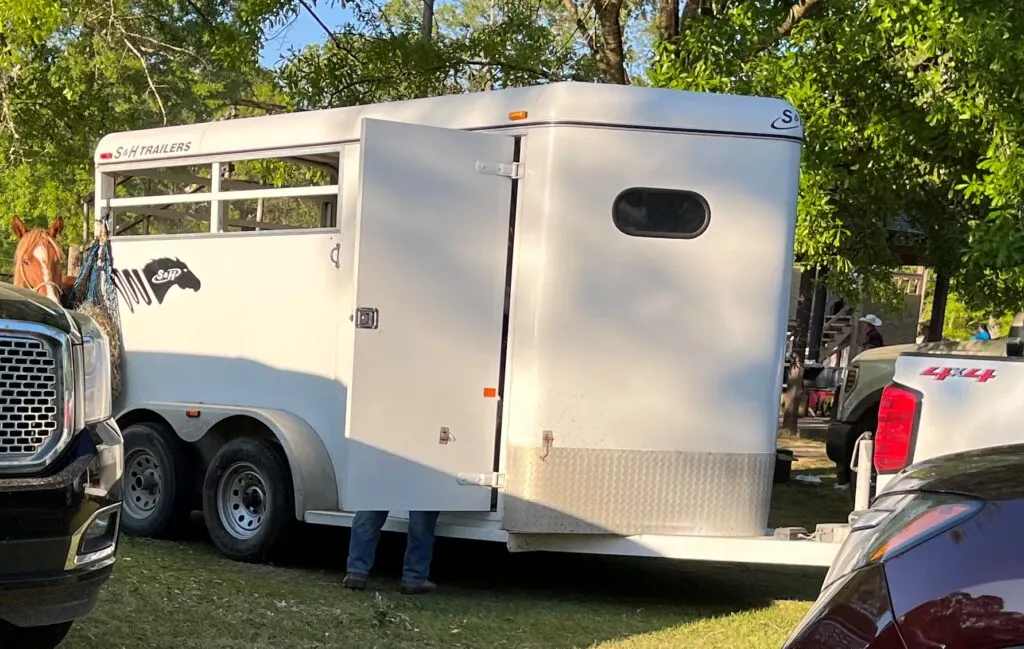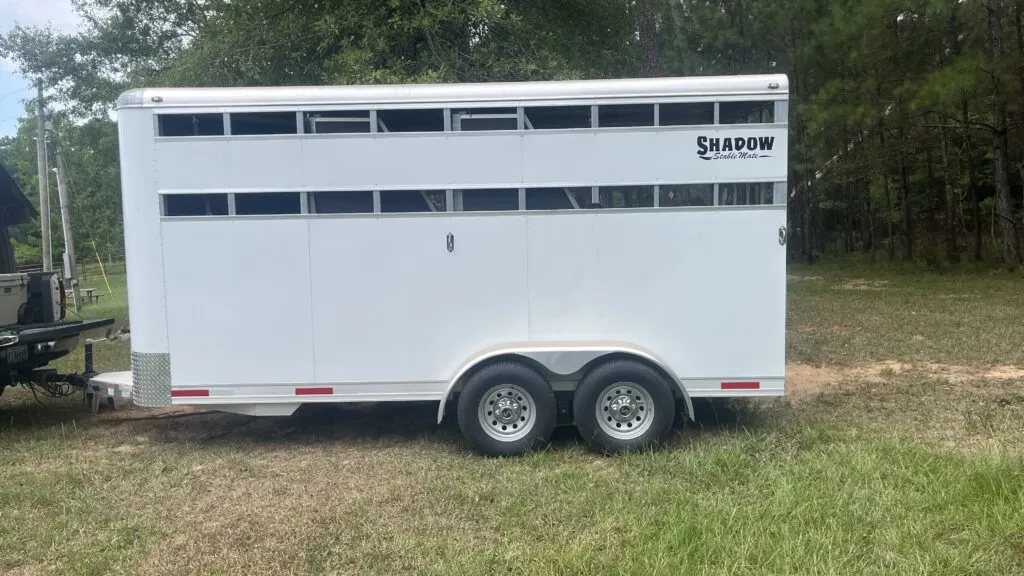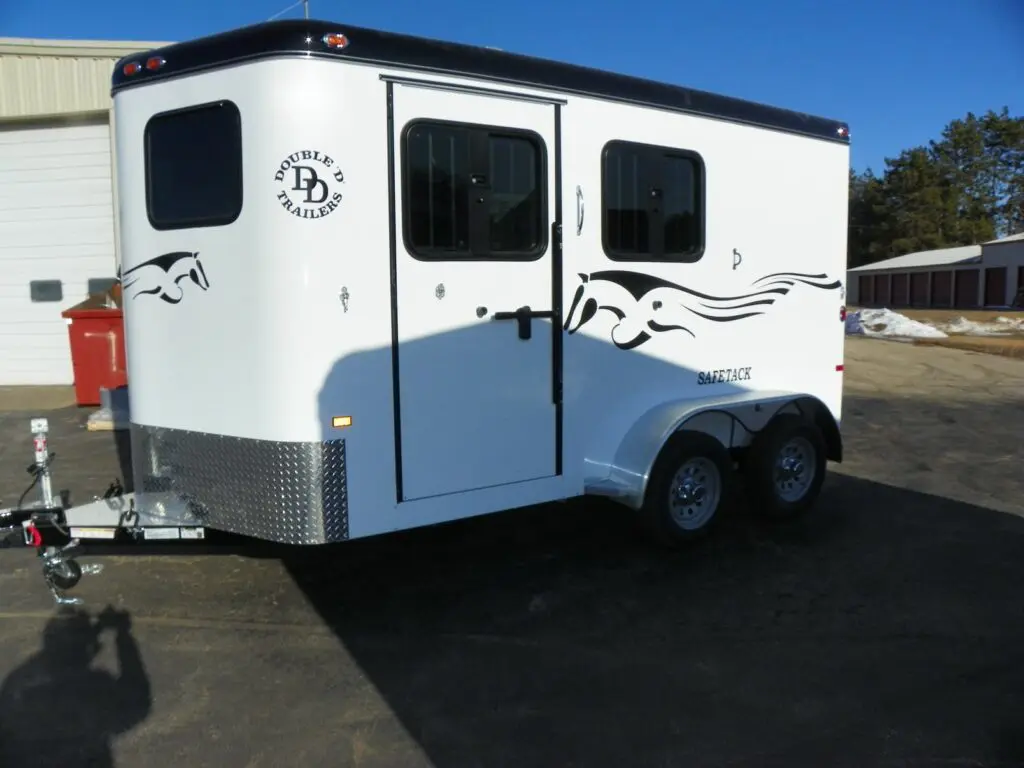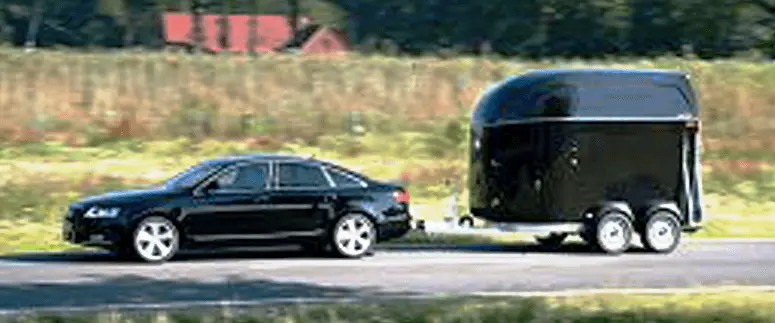Last updated: October 11, 2023
Any links on this page that lead to products on Amazon are affiliate links and I earn a commission if you make a purchase. Thanks in advance – I really appreciate it!
Traveling with your horse is fun, and it opens doors to new adventures for you and your horse. If you’ve never hauled a horse, take your time choosing a tow vehicle and trailer. Research as much as possible; picking the proper rig (tow vehicle and trailer) is critical.
Do you only need to haul two horses? If so, two-horse bumper pull trailers are excellent, and you don’t need a big truck to pull them. Plus, you have the option of hauling your horses with an SUV.
There are a few conveniences you give up when you elect to go with a bumper pull versus a gooseneck. But overall, what you give up is small compared to what you save.

Bumper-pull trailers are easy to tow.
Individuals that haul one or two horses commonly use bumper pull horse trailers. Bumper-pull trailers have a coupling that extends out from the front and connects to a trailer ball mounted on the tow vehicle’s rear.
Almost every truck and most SUVs come with a tow package. The tow package is secured to the frame and extends under the bumper, where the ball is attached. Even though these types of trailers are called bumper pulls, they aren’t connected to a bumper.
The trailer ball doesn’t attach to your bumper.
An adequately secured bumper-pull trailer towed with the correctly rated vehicle hauls just as good as a gooseneck. Bumper pull trailers usually are smaller and lighter than a gooseneck trailer, making them ideal for pulling behind a lighter-weight vehicle.
Two-horse models are the most common bumper-pull trailers.
The two-horse bumper pull horse trailer is the most widely used trailer for hauling one or two horses. There are good reasons for these trailers to be so popular:
Bumper-pull trailers are cheaper than goosenecks.
The price of a new bumper pull horse trailer is substantially less than a gooseneck trailer. Gooseneck trailers are PRICEY! How dealers justify the price difference is a mystery.
Bumper pull trailers don’t take up truck bed space.
It’s nice to have the truck bed available to load equipment, feed, and hay during a trip. A gooseneck trailer uses up most of the truck bed. You might fit in a few little things here and there, but you’re losing a lot of the truck’s storage space.
Bumper pull trailers aren’t expensive.
Bumper pull trailers are lighter, and you don’t need a gas guzzler to haul one. The combination of a more lightweight trailer and a small tow vehicle adds up to significant fuel savings. Goosenecks are heavy, and most have a higher profile, reducing fuel efficiency.

Lots of choices of tow vehicles with a bumper pull trailer.
Bumper pull trailers are lighter weight which translates into a more extensive selection of vehicles that can tow them. Most major trailer manufacturers offer a wide selection of bumper models, ranging from two to four horses.
Bumper-pull trailers are easy to handle.
Bumper pull trailers follow the tow vehicle around curves. However, I find backing up a gooseneck easier, and my son finds both easy to back up, so it is a personal preference.
Most bumper-pull trailers don’t require a CDL license.
You may not need a CDL (Commercial Drivers License) to pull a bumper pull trailer. Depending on the total weight of your rig, you might not need a CDL. Check the laws in your state.
You can click here to check the Federal Motor Carrier Safety Administrations website for the current regulations regarding CDL requirements.
An average two-horse bumper-pull trailer weighs near 2500 lbs.
Generally, an empty two-horse bumper-pull trailer made of standard materials weighs close to 2500 lbs. Commonly, a combination of aluminum and steel composite.
The weight varies from the standard by style and material. For example, adding a dressing room to a standard model increases the trailer’s weight by 700 lbs.
Also, steel trailers weigh slightly more, at 2900 lbs., and European models weigh less. A standard comfort Bockmann weighs about 2000 lbs.

Trailer weight matters in determining GVW.
The trailer’s weight is needed to determine the gross vehicle weight or GVW. The GVW is the maximum weight a trailer can safely hold and haul. It is calculated by adding the weight of the trailer and the load of the trailer.
The GVW is needed to ensure the vehicle is designed to pull the trailer and horse you intend to haul. Before buying a trailer, it’s essential to know the weight of the horse or horses you plan to carry, plus anything else you may put in the trailer. Allow for the weight of all equipment, hay, and feed in the trailer.
For example, if a trailer weighs 2,500 lbs and has a GVW of 10,000 lbs, you would have an available load capacity of 7,500 lbs for this trailer. 10,000 GVW-2,500 trailer weight equal 7,500 lbs.
7,500 lbs is a sufficient amount of available capacity for everything a person should need. In the above example, you can haul two 1,100-pound horses and still have over 5000 pounds of available load capacity for other items.
Exceeding your trailer GVW is dangerous. Trailers are built with different types of axles, and these axles are rated to carry different-sized loads. A trailer GVW is based on the load the axels can safely bear.
When you exceed the GVW, you could decrease the trailer’s stability and start swerving on the road. (Click here to read our article on the heights of horse trailers)
What Vehicles Can Tow a Two-Horse Trailer?
You may be wondering why the weight of the trailer is so important. Well, it’s because of safety; you need to know not only how much your trailer can safely haul but also that your vehicle can pull the trailer safely on the road.
All the major brand full-sized trucks and SUVs can safely haul a loaded two-horse bumper-pull horse trailer. To ensure a vehicle has the proper capabilities to pull a trailer, go to the NADA website, and enter your vehicle information.
Towing capacity is based on the vehicle’s gross combined weight rating (GCWR). The GCWR is the maximum weight a vehicle can safely pull, plus the vehicle’s weight and load.
If your total is close to the GCWR of the vehicle you are considering buying, you should move up to the next level. The price difference will be made up by less wear and tear on your vehicle and make for a safer ride.

Tongue weight is listed on all new trailers.
Another factor to consider is tongue weight or hitch weight. Automakers have a maximum tongue weight listed for their vehicles. The tongue weight on American-built trailers is commonly 10-15 percent of the trailer’s weight. European trailers are designed to put less weight on trailer tongues.
In our above example, we calculated a little under 5,000 lbs GVW. With this information, we can begin to scour the market to find a proper vehicle to pull the trailer.
Some SUVs can pull a Two Horse Trailer.
Most full-sized SUVs are designed with the necessary capacity to tow a two-horse trailer. To increase safety when hauling some SUVs, consider installing a weight distribution hitch. The below chart includes the towing capacity of popular SUV models.
| SUV | Max Towing |
|---|---|
| Ford Expedition | 9,300 Lbs. |
| Dodge Durango SRT | 8,700 Lbs |
| Lincoln Navigator | 8,700 Lbs |
| Chevrolet Tahoe | 8,500 Lbs. |
| Infiniti QX80 | 8,500 Lbs. |
| Jeep Grand Cherokee | 7,200-lb |
| Land Rover Discovery | 8,201 Lbs. |
| Toyota Land Cruiser | 8,100 Lbs |
| Nissan Pathfinder | 6,000-lb |
Some trucks need a weight-distributing hitch.
Weight distribution hitches are required when using a bumper trailer hitch ball on some vehicles. Midsized trucks are required to have them on vehicles towing over 5,000 lbs. Heavy trucks are required to have if the trailer weight is from 6,000 to 8,000, depending on the style of the truck.
Weight-distributing hitches improve safety. With a properly installed weight-distributing hitch, your load is evenly distributed over the axles on the trailer, giving you more stability and control.
Weight-distributing hitches keeps your vehicle level.
The safety hitch keeps your vehicle and trailer level and prevents swaying. Depending on your trailer’s tongue weight, the rear of your vehicle could be pushed low, creating a dangerous driving condition.
Weight distribution hitches aren’t cheap, and they cost anywhere from $200-$1,000. You can click on this link to check the current prices of weight distribution hitches.
If you intend to pull your trailer with an SUV, you need to check into purchasing a weight-distributing hitch. Check with a qualified installer or a dealer to advise you on the proper hitch for your vehicle.
If you have ever had a trailer sway behind you, you know how dangerous it can be. So for your driving safety, have your vehicle properly equipped before you start hauling. Click on this link to read our article on the best weight-distributing hitches currently on the market.

Cars can pull a horse trailer.
Yes, cars can and do pull horse trailers. European horse trailers are designed to be lightweight with low tongue weight. These specially designed trailers are often towed by cars in Europe. They are available in the United States; you can click on this website to learn more about Böckmann trailers.
Always check the towing capacity before you hook a horse trailer to your car.
Hitching a bumper-pull trailer to a vehicle is easy.
This YouTube video provides tips for towing your horse trailer.
Don’t exceed 65 mph when towing a horse trailer.
The answer to this question depends on your truck and trailer. A proper rig should travel no more than 65 mph on interstates and not more than 55 mph on highways.
Horse trailers have special trailer tires. These tires are rated for a maximum speed of 65 mph. When transporting horses, always focus on safety. Do a pre-trip check of your trailer and hook-up. Ensure your lights are working correctly and your horse has proper ventilation.
Travel with the care you and your horse deserve.
FAQ
How much does a two-horse trailer weigh?
On average, a standard two-horse trailer weighs about 2,500 lbs. However, they vary by brand, style, and material. For example, a two-horse trailer with a dressing room made of steel can weigh 4,000 lbs unloaded.
To get an accurate weight on a specific trailer, contact its manufacturer.
Related articles:
- Click here to read our article on the 10 best bumper pull trailers on the market.
- Click here to check out “must-have” trailer accessories.
Meet Miles Henry
An avid equestrian and seasoned racehorse owner, Miles Henry brings his extensive experience to the equine world, proudly associating with the AQHA, The Jockey Club, and various other equine organizations. Beyond the racetrack, Miles is an accomplished author, having published various books about horses, and is a recognized authority in the field, with his work cited in multiple publications.
🔗 Connect with Miles:
Twitter
Facebook
YouTube: Check out race highlights, horse care tips, and more!

